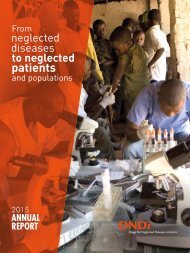TUBERCULOSIS
9789241565394-eng
9789241565394-eng
Create successful ePaper yourself
Turn your PDF publications into a flip-book with our unique Google optimized e-Paper software.
:: Box 2.2<br />
Sustainable Development Goal 3<br />
and its 13 targets<br />
SDG3: Ensure healthy lives and promote well-being for all at all ages<br />
Targets<br />
3.1 By 2030, reduce the global maternal mortality ratio to less than<br />
70 per 100 000 live births<br />
3.2 By 2030, end preventable deaths of new-borns and children<br />
under 5 years of age, with all countries aiming to reduce neonatal<br />
mortality to at least as low as 12 per 1000 live births and under-5<br />
mortality to at least as low as 25 per 1000 live births<br />
3.3 By 2030, end the epidemics of AIDS, tuberculosis, malaria and<br />
neglected tropical diseases and combat hepatitis, water-borne<br />
diseases and other communicable diseases<br />
3.4 By 2030, reduce by one third premature mortality from noncommunicable<br />
diseases through prevention and treatment and<br />
promote mental health and wellbeing<br />
3.5 Strengthen the prevention and treatment of substance abuse,<br />
including narcotic drug abuse and harmful use of alcohol<br />
3.6 By 2020, halve the number of global deaths and injuries from<br />
road traffic accidents<br />
3.7 By 2030, ensure universal access to sexual and reproductive<br />
health-care services, including for family planning, information<br />
and education, and the integration of reproductive health into<br />
national strategies and programmes<br />
3.8 Achieve universal health coverage, including financial risk<br />
protection, access to quality essential health-care services<br />
and access to safe, effective, quality and affordable essential<br />
medicines and vaccines for all<br />
3.9 By 2030, substantially reduce the number of deaths and illnesses<br />
from hazardous chemicals and air, water and soil pollution and<br />
contamination<br />
3.a Strengthen the implementation of the World Health Organization<br />
Framework Convention on Tobacco Control in all countries, as<br />
appropriate<br />
3.b Support the research and development of vaccines and medicines<br />
for the communicable and non-communicable diseases that<br />
primarily affect developing countries, provide access to affordable<br />
essential medicines and vaccines, in accordance with the Doha<br />
Declaration on the TRIPS Agreement and Public Health, which<br />
affirms the right of developing countries to use to the full the<br />
provisions in the Agreement on Trade-Related Aspects of<br />
Intellectual Property Rights regarding flexibilities to protect public<br />
health, and, in particular, provide access to medicines for all<br />
3.c Substantially increase health financing and the recruitment,<br />
development, training and retention of the health workforce in<br />
developing countries, especially in least developed countries and<br />
small island developing States<br />
3.d Strengthen the capacity of all countries, in particular developing<br />
countries, for early warning, risk reduction and management of<br />
national and global health risks<br />
TRIPS, Trade-Related Aspects of Intellectual Property Rights<br />
raphy (e.g. urban versus rural), wealth (e.g.<br />
bottom 40%, or bottom versus top income<br />
quintiles) and employment status. Some<br />
indicators also give particular attention to<br />
specific subpopulations, such as pregnant<br />
women, people with disabilities, victims of<br />
work injuries and migrants.<br />
Disaggregation is intended to inform<br />
analysis of within-country inequalities and<br />
associated assessments of equity, as a basis<br />
for identifying particular areas or subpopulations<br />
where progress is lagging and greater<br />
attention is needed. This is an important<br />
consideration for the TB community, given<br />
the influence of socio-economic status and<br />
access to health care on TB epidemiology.<br />
Chapter 3 of this report includes examples<br />
of within-country analyses of TB data; it also<br />
illustrates across-country inequities in access<br />
to TB diagnosis and treatment using the<br />
case fatality ratio (CFR), one of the top 10<br />
indicators for monitoring implementation of<br />
the End TB Strategy (see Section 2.2).<br />
2.2 The End TB Strategy<br />
In 2012, in anticipation of the end of the eras<br />
of the MDGs and Stop TB Strategy, WHO’s<br />
Global TB Programme initiated the development<br />
of a post-2015 global TB strategy.<br />
Following 2 years of consultations, the proposed<br />
strategy was discussed at the 2014<br />
World Health Assembly, where it was unanimously<br />
endorsed by all Member States. 1<br />
That strategy is now known as the End TB<br />
Strategy. 2<br />
The End TB Strategy “at a glance” is shown<br />
in Box 2.3. It covers the period 2016–2035<br />
and the overall goal is to “End the global TB<br />
epidemic”, defined as around 10 new cases<br />
per 100 000 population per year. This is the<br />
level found in countries considered to have a<br />
low burden of TB in 2015 (Chapter 3).<br />
The End TB Strategy has three high-level,<br />
overarching indicators and related targets<br />
(for 2030, linked to the SDGs, and for 2035)<br />
and milestones (for 2020 and 2025). The<br />
three indicators are:<br />
1<br />
World Health Assembly. Global strategy and targets<br />
for tuberculosis prevention, care and control after<br />
2015 (WHA67.1, Agenda item 12.1). Geneva: World<br />
Health Assembly; 2014 (http://apps.who.int/gb/<br />
ebwha/pdf_files/WHA67/A67_R1-en.pdf, accessed<br />
28 July 2016).<br />
2<br />
Uplekar M, Weil D, Lonnroth K, Jaramillo E,<br />
Lienhardt C, Dias HM, et al. WHO’s new End TB<br />
Strategy. Lancet. 2015;385(9979):1799–1801<br />
(http://www.ncbi.nlm.nih.gov/pubmed/25814376,<br />
accessed 28 July 2016).<br />
8 :: GLOBAL <strong>TUBERCULOSIS</strong> REPORT 2016



